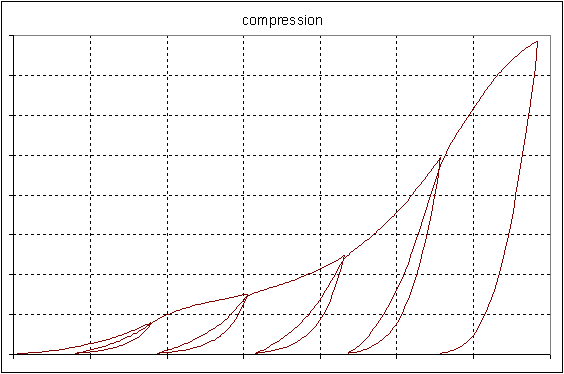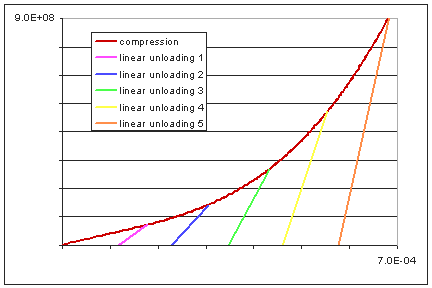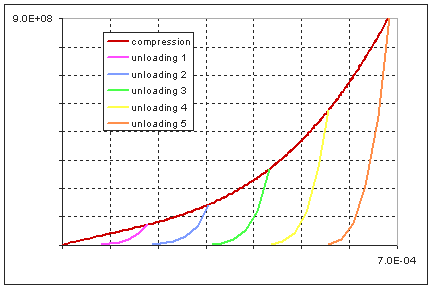The TB command option GASKET enables gasket joints to be simulated with the interface elements, in which there is only one element through the thickness, and the through-thickness deformation is decoupled from the in plane deformation. The gasket material is usually under compression. The material under compression is highly nonlinear. The gasket material also exhibits quite complicated unloading behavior when compression is released. The GASKET option enables you to directly input data for the experimentally measured complex pressure closure curve for the material model (compression curve), and also for several unloading pressure closure curves. When no unloading curves are defined, the material behavior follows the compression curve while it is unloaded.
As it is a joint component, there often exists an initial gap or void. On the other hand, from a modeling point of view, it is a lot easier to fill the spaces or volumes between the adjacent components with the interface meshes, and then set an initial gap for the gasket material to account for it. As long as the closure is less than the initial gap, no pressure is acted on the gaskets. Also, when it is under tension loading, there will be an open gap. Therefore, gasket joints generally do not have tension pressure. A stress cap is used to restrict tension pressure in the gasket joint elements.
The GASKET material option must be used with interface elements INTER192, INTER193, INTER194, and INTER195.
Figure 10.2: Pressure vs. Closure Behavior of a Gasket Material shows the experimental pressure vs. closure (relative displacement of top and bottom gasket surfaces) data for a graphite composite gasket material. The sample was unloaded and reloaded 5 times along the loading path and then unloaded at the end of the test to determine the materials unloading stiffness.
You input gasket material data using TB,GASKET. The material data consists of 2 main parts: general parameters and pressure closure behaviors. The general parameters define initial gasket gap, stable stiffness for numerical stabilization, and stress cap for a gasket in tension. The pressure closure behavior includes gasket compression (loading) and tension data (unloading).
The TB command specification for defining a gasket material is:
TB,GASKET,MAT,NTEMP,NPTS,TBOPT
where TBOPT = one of the following types of gasket
material data:
PARA: gasket material general parameters.
COMP: gasket compression data.
LUNL: gasket linear unloading data.
NUNL: gasket nonlinear unloading data.
TSS: gasket transverse shear stiffness data.
You input the general parameters using the TBDATA command, then input the compression and unloading data using the TBPT command.
Presented in the following sections are examples of inputs for the various types of gasket data.
(TBOPT = PARA)
The gasket material general parameters include the initial gap, stable stiffness and the maximum tension stress cap. These parameters are defined as C1, C2, and C3 in the following example:
TB,GASKET,MAT,NTEMP,NPTS,PARA TBDATA,1,C1,C2,C3
Refer to Gasket Materials in the Material Reference for further details on these parameters.
(TBOPT = COMP)
The compression pressure closure curve gasket material definition option is defined as follows:
TB,GASKET,MAT,NTEMP,NPTS,COMP TBPT,,x1,y1 TBPT,,x2,y2 TBPT,,xi,yi
where: xi, yi are pairs of closure and pressure values.
The following input listing is an example defining a compressive pressure vs. closure behavior of a gasket joint material with 10 data points.
TB,GASKET,1, ,10,COMP ! define compression data TBPT,, 0.20000E-04, 0.54000E+08 TBPT,, 0.40000E-04, 0.15150E+09 TBPT,, 0.60000E-04, 0.24900E+09 TBPT,, 0.78000E-04, 0.30000E+09 TBPT,, 0.12000E-03, 0.37200E+09 TBPT,, 0.19000E-03, 0.47400E+09 TBPT,, 0.28600E-03, 0.58500E+09 TBPT,, 0.35800E-03, 0.67350E+09 TBPT,, 0.43200E-03, 0.78000E+09 TBPT,, 0.50500E-03, 0.89550E+09
(TBOPT = LUNL)
The linear unloading gasket material definition option is a simple way to define the gasket unloading behavior. Several unloading slopes can be defined to accommodate the comprehensive unloading behavior as follows:
TB,GASKET,MAT,NTEMP,NPTS,LUNL TBPT,,x1,y1 TBPT,,x2,y2 TBPT,,xi,yi
where: NPTS is the number of unloading points; xi
is the closure where unloading started, and yi is unloading slope.
The following input listing is an example showing the linear unloading behavior of a gasket joint material with 3 unloading points
TB,GASKET,1, ,3,LUNL ! define linear unloading data TBPT,, 0.78000E-04, 0.25100E+12 TBPT,, 0.28600E-03, 0.25500E+12 TBPT,, 0.50500E-03, 0.10600E+13
A sample plot representing linear unloading curves is shown in Figure 10.3: Gasket Material Input: Linear Unloading Curves.
(TBOPT = NUNL)
The nonlinear unloading gasket material definition option provides a more comprehensive way of defining gasket material unloading behavior. The input listing format is:
TB,GASKET,MAT,NTEMP,NPTS,NUNL TBPT,,x1,y1 TBPT,,x2,y2 TBPT,,xi,yi
where: xi, yi are pairs of closure and pressure values. Several unloading curves can be defined.
An example showing the nonlinear unloading behavior of a gasket joint material with 3 unloading points is as follows:
TB,GASKET,1, ,5,NUNL ! define first nonlinear unloading data TBPT,, 0.78000E-04, 0.30000E+09 TBPT,, 0.66900E-04, 0.24750E+08 TBPT,, 0.63100E-04, 0.82500E+07 TBPT,, 0.54100E-04, 0.15000E+07 TBPT,, 0.00000E+00, 0.00000E+00 TB,GASKET,1, ,5,NUNL ! define second nonlinear unloading data TBPT,, 0.28600E-03, 0.58500E+09 TBPT,, 0.26400E-03, 0.22350E+08 TBPT,, 0.26100E-03, 0.90000E+07 TBPT,, 0.25600E-03, 0.15000E+07 TBPT,, 0.00000E+00, 0.00000E+00 TB,GASKET,1, ,5,NUNL ! define third nonlinear unloading data TBPT,, 0.50500E-03, 0.89550E+09 TBPT,, 0.47800E-03, 0.33900E+08 TBPT,, 0.47500E-03, 0.13500E+08 TBPT,, 0.46800E-03, 0.15000E+07 TBPT,, 0.00000E+00, 0.00000E+00
A sample plot representing nonlinear unloading curves is shown in Figure 10.4: Gasket Material Input: Nonlinear Unloading Curves.
Inputting temperature dependent gasket material properties follows the standard procedure for inputting temperature dependent data for other materials. The following format shows this procedure.
TB,GASKET,MAT,NTEMP,NPTS,LUNL TBTEMP,T1 TBPT,,x1,y1 TBPT,,x2,y2 TBTEMP,T2 TBPT,,x1,y1 TBPT,,x2,y2
Mechanical APDL interpolates the temperature data to the material points automatically using linear interpolation. When the temperature is out of the specified range, the closest temperature point is used.
The following is an example input listing defining a compressive pressure vs. closure behavior of a gasket joint material with 5 temperature points and up to 10 data points for each temperature point, and 3 nonlinear unloading curves with each curve having 5 temperatures and 5 data points.
TB,GASKET,1, 5,10,COMP ! define compression data with 5 temperatures TBTEMP, 100.000 TBPT,, 0.20000E-04, 0.54000E+08 TBPT,, 0.40000E-04, 0.15150E+09 TBPT,, 0.60000E-04, 0.24900E+09 TBPT,, 0.78000E-04, 0.30000E+09 TBPT,, 0.12000E-03, 0.37200E+09 TBPT,, 0.19000E-03, 0.47400E+09 TBPT,, 0.28600E-03, 0.58500E+09 TBPT,, 0.35800E-03, 0.67350E+09 TBPT,, 0.43200E-03, 0.78000E+09 TBPT,, 0.50500E-03, 0.89550E+09 TBTEMP, 200.000 TBPT,, 0.20000E-04, 0.18000E+08 TBPT,, 0.40000E-04, 0.50500E+08 TBPT,, 0.60000E-04, 0.83000E+08 TBPT,, 0.78000E-04, 0.10000E+09 TBPT,, 0.12000E-03, 0.12400E+09 TBPT,, 0.19000E-03, 0.15800E+09 TBPT,, 0.28600E-03, 0.19500E+09 TBPT,, 0.35800E-03, 0.22450E+09 TBPT,, 0.43200E-03, 0.26000E+09 TBPT,, 0.50500E-03, 0.29850E+09 TBTEMP, 300.000 TBPT,, 0.20000E-04, 0.90000E+07 TBPT,, 0.40000E-04, 0.25250E+08 TBPT,, 0.60000E-04, 0.41500E+08 TBPT,, 0.78000E-04, 0.50000E+08 TBPT,, 0.12000E-03, 0.62000E+08 TBPT,, 0.19000E-03, 0.79000E+08 TBPT,, 0.28600E-03, 0.97500E+08 TBPT,, 0.35800E-03, 0.11225E+09 TBPT,, 0.43200E-03, 0.13000E+09 TBPT,, 0.50500E-03, 0.14925E+09 TBTEMP, 400.000 TBPT,, 0.20000E-04, 0.36000E+07 TBPT,, 0.40000E-04, 0.10100E+08 TBPT,, 0.60000E-04, 0.16600E+08 TBPT,, 0.78000E-04, 0.20000E+08 TBPT,, 0.12000E-03, 0.24800E+08 TBPT,, 0.19000E-03, 0.31600E+08 TBPT,, 0.28600E-03, 0.39000E+08 TBPT,, 0.35800E-03, 0.44900E+08 TBPT,, 0.43200E-03, 0.52000E+08 TBPT,, 0.50500E-03, 0.59700E+08 TBTEMP, 500.000 TBPT,, 0.20000E-04, 0.18000E+07 TBPT,, 0.40000E-04, 0.50500E+07 TBPT,, 0.60000E-04, 0.83000E+07 TBPT,, 0.78000E-04, 0.10000E+08 TBPT,, 0.12000E-03, 0.12400E+08 TBPT,, 0.19000E-03, 0.15800E+08 TBPT,, 0.28600E-03, 0.19500E+08 TBPT,, 0.35800E-03, 0.22450E+08 TBPT,, 0.43200E-03, 0.26000E+08 TBPT,, 0.50500E-03, 0.29850E+08 TB,GASKET,1, 5,5,NUNL ! define first nonlinear unloading data with 5 temperatures TBTEMP, 100.000 TBPT,, 0.78000E-04, 0.30000E+09 TBPT,, 0.66900E-04, 0.24750E+08 TBPT,, 0.63100E-04, 0.82500E+07 TBPT,, 0.54100E-04, 0.15000E+07 TBPT,, 0.00000E+00, 0.00000E+00 TBTEMP, 200.000 TBPT,, 0.78000E-04, 0.10000E+09 TBPT,, 0.66900E-04, 0.82500E+07 TBPT,, 0.63100E-04, 0.27500E+07 TBPT,, 0.54100E-04, 0.50000E+06 TBPT,, 0.00000E+00, 0.00000E+00 TBTEMP, 300.000 TBPT,, 0.78000E-04, 0.50000E+08 TBPT,, 0.66900E-04, 0.41250E+07 TBPT,, 0.63100E-04, 0.13750E+07 TBPT,, 0.54100E-04, 0.25000E+06 TBPT,, 0.00000E+00, 0.00000E+00 TBTEMP, 400.000 TBPT,, 0.78000E-04, 0.20000E+08 TBPT,, 0.66900E-04, 0.16500E+07 TBPT,, 0.63100E-04, 0.55000E+06 TBPT,, 0.54100E-04, 0.10000E+06 TBPT,, 0.00000E+00, 0.00000E+00 TBTEMP, 500.000 TBPT,, 0.78000E-04, 0.10000E+08 TBPT,, 0.66900E-04, 0.82500E+06 TBPT,, 0.63100E-04, 0.27500E+06 TBPT,, 0.54100E-04, 0.50000E+05 TBPT,, 0.00000E+00, 0.00000E+00 TB,GASKET,1, 5,5,NUNL ! define second nonlinear unloading data with 5 temperatures TBTEMP, 100.000 TBPT,, 0.28600E-03, 0.58500E+09 TBPT,, 0.26400E-03, 0.22350E+08 TBPT,, 0.26100E-03, 0.90000E+07 TBPT,, 0.25600E-03, 0.15000E+07 TBPT,, 0.00000E+00, 0.00000E+00 TBTEMP, 200.000 TBPT,, 0.28600E-03, 0.19500E+09 TBPT,, 0.26400E-03, 0.74500E+07 TBPT,, 0.26100E-03, 0.30000E+07 TBPT,, 0.25600E-03, 0.50000E+06 TBPT,, 0.00000E+00, 0.00000E+00 TBTEMP, 300.000 TBPT,, 0.28600E-03, 0.97500E+08 TBPT,, 0.26400E-03, 0.37250E+07 TBPT,, 0.26100E-03, 0.15000E+07 TBPT,, 0.25600E-03, 0.25000E+06 TBPT,, 0.00000E+00, 0.00000E+00 TBTEMP, 400.000 TBPT,, 0.28600E-03, 0.39000E+08 TBPT,, 0.26400E-03, 0.14900E+07 TBPT,, 0.26100E-03, 0.60000E+06 TBPT,, 0.25600E-03, 0.10000E+06 TBPT,, 0.00000E+00, 0.00000E+00 TBTEMP, 500.000 TBPT,, 0.28600E-03, 0.19500E+08 TBPT,, 0.26400E-03, 0.74500E+06 TBPT,, 0.26100E-03, 0.30000E+06 TBPT,, 0.25600E-03, 0.50000E+05 TBPT,, 0.00000E+00, 0.00000E+00 TB,GASKET,1, 5,5,NUNL ! define third nonlinear unloading data with 5 temperatures TBTEMP, 100.000 TBPT,, 0.50500E-03, 0.89550E+09 TBPT,, 0.47800E-03, 0.33900E+08 TBPT,, 0.47500E-03, 0.13500E+08 TBPT,, 0.46800E-03, 0.15000E+07 TBPT,, 0.00000E+00, 0.00000E+00 TBTEMP, 200.000 TBPT,, 0.50500E-03, 0.29850E+09 TBPT,, 0.47800E-03, 0.11300E+08 TBPT,, 0.47500E-03, 0.45000E+07 TBPT,, 0.46800E-03, 0.50000E+06 TBPT,, 0.00000E+00, 0.00000E+00 TBTEMP, 300.000 TBPT,, 0.50500E-03, 0.14925E+09 TBPT,, 0.47800E-03, 0.56500E+07 TBPT,, 0.47500E-03, 0.22500E+07 TBPT,, 0.46800E-03, 0.25000E+06 TBPT,, 0.00000E+00, 0.00000E+00 TBTEMP, 400.000 TBPT,, 0.50500E-03, 0.59700E+08 TBPT,, 0.47800E-03, 0.22600E+07 TBPT,, 0.47500E-03, 0.90000E+06 TBPT,, 0.46800E-03, 0.10000E+06 TBPT,, 0.00000E+00, 0.00000E+00 TBTEMP, 500.000 TBPT,, 0.50500E-03, 0.29850E+08 TBPT,, 0.47800E-03, 0.11300E+07 TBPT,, 0.47500E-03, 0.45000E+06 TBPT,, 0.46800E-03, 0.50000E+05 TBPT,, 0.00000E+00, 0.00000E+00
Sample plots of compression and unloading curves for gasket data to two temperatures are shown in Figure 10.5: Gasket Compression and Unloading Curves at Two Temperatures.
You can plot gasket compression, linear unloading and nonlinear unloading data using the TBPLOT command. The use of this command to plot gasket data is as follows:
TBPLOT,GASKET,MAT,TBOPT,TEMP,SEGN
where TBOPT specifies the gasket material option to be
plotted, TEMP specifies plotting either all of the
temperature dependent data curves, or a curve at a specified temperature, and
SEGN specifies whether or not to add the segment
numbers to the curves.





